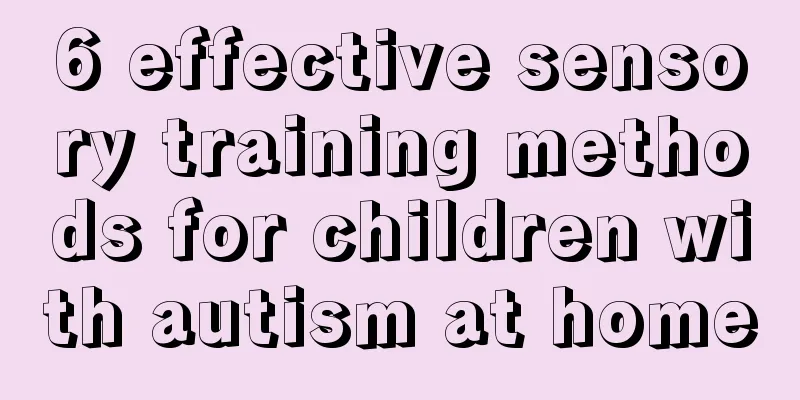Why does a 6-year-old boy sweat a lot when sleeping at night?

|
Summer is here and the weather is hot. Most people will sweat profusely after activities. It is normal to sweat in moderation, but you should pay attention if you sweat too much. A 6-year-old baby is in the stage of development. Babies at this stage should pay attention to a balanced diet. If a 6-year-old baby sweats particularly a lot, you should pay attention. Calcium deficiency and other reasons cannot be ruled out. Why does a 6-year-old boy sweat a lot when he sleeps at night? Let’s take a look at it next. 1. Why does a 6-year-old boy sweat a lot when sleeping at night? If your baby has the above symptoms, it is considered that night sweats are caused by calcium deficiency or weak constitution. It is recommended to conduct trace element determination and examination. 2. Symptoms of calcium deficiency Calcium supplementation is a topic that has been talked about for a long time. So what symptoms does a baby have that indicate calcium deficiency? If your baby is a night cryer, often cries in the middle of the night, sweats a lot, is easily frightened, and has a circle of bald hair behind the pillow, then your baby is calcium deficient. If calcium is not supplemented at this time, it will develop into rickets in the later stage and cause bone changes, such as skull softening, square skull, occipital baldness, enlarged anterior fontanelle, delayed closure, pigeon chest, funnel chest, rib valgus, X-shaped or O-shaped legs, and even symptoms such as convulsions, spasms, and laryngeal spasm. In short, any result is not what parents want to see. According to the "Dietary Reference Intake Table for Chinese Residents" released by the Chinese Nutrition Society, the appropriate daily calcium intake for infants and young children is divided into age groups: 300 mg for 0-6 months, 400 mg for 6-12 months, and 600 mg for 1-3 years. When the intake exceeds this amount and increases further, the risk of toxic side effects will increase. If your baby is not calcium deficient, there is no need to supplement calcium blindly. 3. Calcium-supplementing foods 1. Black beans Black beans are also rich in calcium, higher than ordinary soybeans. The protein content in black beans is twice that of meat, three times that of eggs, and 12 times that of milk. Black beans contain 18 kinds of amino acids, especially 8 essential amino acids for the human body. Black beans basically contain no cholesterol, only plant sterols, which are not absorbed and utilized by the human body. They can inhibit the body's absorption of cholesterol and reduce the cholesterol content in the blood. Therefore, eating black beans regularly can soften blood vessels, moisturize the skin and delay aging. It is especially beneficial for patients with high blood pressure, heart disease, etc. Eating black beans regularly can provide crude fiber in food, promote digestion and prevent constipation. 2. Kelp Kelp is rich in calcium and other nutrients needed by the human body. 3. Black Fungus In addition to lowering blood pressure, black fungus is also a strong calcium supplement. It also has the effects of invigorating qi, satisfying hunger, lightening the body and strengthening the mind, stopping bleeding and relieving pain, replenishing blood and activating blood circulation, and fighting cancer. The gelatin in wood ear can absorb and concentrate the dust and impurities remaining in the human digestive system and excrete them out of the body, thereby playing a role in clearing the stomach and intestines. At the same time, it also helps digest fiber substances, and can dissolve and melt indigestible foreign matter such as hair, husks, wood residues, sand, metal chips, etc. that are accidentally eaten. It also has a relatively significant function in dissolving endogenous foreign bodies such as gallstones and kidney stones. 4. Nori It is rich in nutrients, high in iodine and contains a lot of calcium. Rich in choline, calcium and iron, it can enhance memory, treat anemia in women and children, promote the growth and health of bones and teeth, and improve the body's immunity. 5. Sea Cucumber Sea cucumbers are rich in calcium and have high nutritional value. It is a typical high-protein, low-fat, low-cholesterol food. 6. Mustard Greens In addition to being high in calcium, mustard greens are also rich in vitamin A, B vitamins, vitamin C and vitamin D. Mustard greens can stimulate appetite, help digestion, refresh the mind and relieve fatigue! It also has the function of detoxification and swelling reduction. It can improve eyesight, relieve diaphragm, relax intestines and promote bowel movements. It can be used as a good food therapy for ophthalmological patients. It can also prevent and treat constipation. It is especially suitable for the elderly and those with habitual constipation. |
<<: What tests are needed for night terrors
>>: Where is the best place for children to learn swimming
Recommend
How to distinguish and treat colds, wind-colds and wind-heats in children?
There may be different situations when children c...
What to do if your child has poor liver function
If a child's liver function is not good, the ...
Children's eye mucus is thick and yellow
In life, there are many children who have a lot o...
What is in the appetizer tea for toddlers?
Many babies grow up drinking milk powder or breas...
What are the reasons for the thinning hair of four-month-old babies?
Watching their baby grow up slowly, I believe tha...
What is the first aid method for a child drowning?
Many parents will let their babies start swimming...
What causes drowsiness in hand, foot and mouth disease?
After a baby is infected with hand, foot and mout...
How to deal with children's separation anxiety
Many parents suffer from separation anxiety among...
Baby crying non-stop
It is normal for babies to cry incessantly during...
Which one should I supplement first if my child is deficient in calcium, iron or zinc?
Children need a lot of nutrition as they grow. If...
What is the best month to wean your baby?
How many months is the best time to wean a baby? ...
What are the causes of abdominal pain in children?
There are many reasons for abdominal pain in chil...
Inguinal hernia in children
Inguinal oblique hernia is still relatively commo...
What should baby poop look like?
Some of the baby's metabolism can usually ref...
What bed is good for newborns?
When welcoming a new life, many families will pre...









